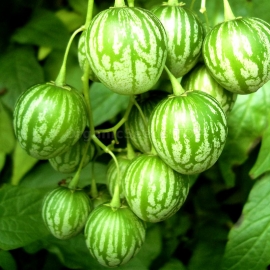 EXCLUSIVE
EXCLUSIVE



Organic Tzimbalo Seeds (Solanum Caripense)
3.90 €
Fruits are small, comparable in size to grapes, but shaped and marked similar to Pepino. The delicious little fruits ripen yellow or pale green, with similar longitudinal striping to Pepino, but they’re much more juicy.
-
Organic Tzimbalo
Fruits are small, comparable in size to grapes, but shaped and marked similar to Pepino. The delicious little fruits ripen yellow or pale green, with similar longitudinal striping to Pepino, but they’re much more juicy.
Flavor is similar to Pepino but is often described as tangier and more complex. Tart, with subtle overtones of cucumber, melon and other fruit flavors. This South American native is suited for both greenhouse and garden cultivation in most of the country, and plants may be overwintered indoors in pots. This is a very rare plant that is started indoors like tomatoes and bears a heavy yield from early August until frost in our Missouri gardens. Harvest when fruit starts to soften. Very exciting, fun and SO delicious.
How to Grow
A close relative of the Pepino Dulce and possibly the wild ancestor from which it was bred. Tzimbalo looks similar to it close cousin, pepino melon but is much smaller [roughly 1 inch round]. The flavor is similar in some respects but has more of a tangy kick to it with hints of its distant cousin the cucumber, where pepino dulce is mildly sweet and not as juicy.
If eaten before fully ripe it can be extremely tart. Don't eat the peel as it leaves a very bad taste in your mouth, to enjoy this fruit it should be skinned. The greenish yellow skin takes on a creamier hue and the white flesh turns yellow when fully ripe. Tzimbalo can endure temperatures as low as the mid 20s [F] for short duration's, but does best in warmer climates.
Leaf drop usually occurs even after a brief chill. It does do well in greenhouses in cooler regions. The plant itself is a shrub that reaches 1 to 3 feet in height. The fruits are born in clusters and ripen to a pale greenish yellow with purplish streaks. Considered part of the nightshade family along with tomatoes and eggplants and should be kept in the same temperature range when grown indoors.
